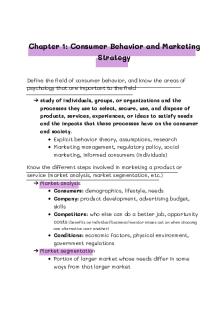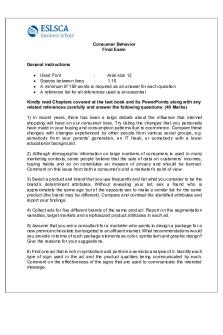Consumer behavior séance 2 PDF

| Title | Consumer behavior séance 2 |
|---|---|
| Author | Maya Ghariani |
| Course | Consumer Behavior |
| Institution | HEC Montréal |
| Pages | 5 |
| File Size | 262.6 KB |
| File Type | |
| Total Downloads | 93 |
| Total Views | 155 |
Summary
Download Consumer behavior séance 2 PDF
Description
Consumer behavior séance 2 – Motivation, Self-concept, Affects. What is motivation? Motivation is defined as the processes that cause consumers to behave as they do. Said otherwise, motivation refers to the reason(s) that drives an observed behavior. Importantly, a given consumption decision (e.g., purchasing an electric car, going to a restaurant, purchasing a luxury watch) may be driven by a number of distinct motivations. For instance, you can observe three consumers purchasing a luxury watch. Although they all purchase the same product at the end of the day, it is possible that they had different motivations that led to the purchase: one may have intended to signal their status, another one may intended to purchase it as a gift to a loved one, and the other one may have wanted to add a new piece to their watch collection. It is noteworthy that it is almost impossible to find a behavior that is driven by one single motivation, and it is extremely important to understand the motivation(s) that drive an observed behavior for designing an effective marketing and communication strategy. Therefore, one of the first steps that a company should take in designing their marketing and communication strategy is to have a good understanding of all the possible motivations that consumers may have for purchasing their offerings. Having identified all possible motivations, the company should select the motivation (or motivations) that they would target given their company’s image, strengths, and characteristics of their offerings. In fact, the motivation (or motivations) that company selects to target creates the basis of different consumer segments.
The motivational process: The motivational process starts with the realization of a need, a discrepancy between the present and an ideal state. A need could be purely utilitarian (i.e., a functional or practical need that is generally purposed to solve a problem), purely hedonic (i.e., an experiential need involving emotional responses), or a combination of the two. Once a need is triggered, in the next step, the need turns into a want, which is shaped by individual differences, culture, and/or environmental factors. For instance, there may be three consumers who need a pair of winter boots. One may want a pair of combat boots, another one may want an ankle boot, and the other may want a pair of old-school winter boots. Next step in the motivational process is the goal. If a consumers wants to satisfy the need of having a pair of winter boots by purchasing a pair of combat boots, then the consumer’s goal would be finding a product that would satisfy this need/want. Finally, the last step is referred to as homeostasis, which is when the need is satisfied.
Motivational conflicts: On occasion, consumers experience motivational conflicts, where two motivations cannot be addressed at the same time. Mainly, there are three types of motivational conflicts:
Approach-approach conflict: Occurs when a consumer must choose between two desirable outcomes. For instance, imagine that you will be taking a vacation and you have to choose between going to Paris and London. In such cases, the companies should try to (1) help consumers simplify their choice and (2) assure consumers that they made the right choice so that consumers do not end up questioning their choice. Approach-avoidance conflict: Occurs when a desirable outcome comes in expense of an undesirable outcome. For instance, you want to eat ice cream but you are trying to lose weight or you want to go to a party but there is a final exam the next day. Please see the next slide for how marketers can help consumers resolve such conflicts. Avoidance-avoidance conflict: Occurs when a consumer must choose between two undesirable outcomes such as studying and cleaning the apartment. In order to help consumers resolve approach-avoidance conflicts, marketers have various strategies such as offering low-calorie or healthier alternatives of products, offering payment plans, engaging in cause marketing activities etc.
Consumer involvement: Involvement refers to a consumer’s perceived relevance of a stimuli (e.g., an ad, a product, a purchase decision), which determines their desire to process relevant information. To simplify, you can consider involvement as the extent to which a consumer pays attention to a piece of information (e.g., an advertisement), a stimuli (e.g., a product) or a task (e.g., purchase decision) Whereas high involvement leads to higher levels of attention paid to stimuli, low involvement leads to lower levels of attention paid to stimuli. There are three main factors that influence consumer involvement: Individual differences such as the how strong/important one’s need is, personal interest on subject, and values. For instance, if you currently need to purchase a laptop, you would be more involved in a laptop ad. In a similar vein, if you have a personal interest in cars, you would be more involved in an article about electric cars compared to someone who does not care about cars. Stimuli factors such as the information source and content. For instance, consumers are more involved in an ad when it features their favorite celebrity/athlete. Situational factors such as consumption context and risk associated with the stimuli. For instance, consumers are more involved in the information about a stimuli such as a product or purchase decision about a product that is consumed publicly (vs. privately). Similarly, consumers are more involved in purchase decisions that are risky 7 in terms of potential negative consequences of making a poor decision (e.g., purchasing a house) compared to those are not risky (e.g., purchasing paper towels) Finally, it is important to have a good understanding of consequences of involvement: increased involvement leads to elicitation of counter-arguments, amplifies perceived differences among products/product attributes, and increases the amount of information search. Therefore, in certain cases, companies may be better off by encouraging consumers to
make low-involvement purchase decisions or to process information with low involvement. For instance, a company that offers indulging products/services or a company that offers products/services with some flaws may benefit from consumers having low involvement.
Affect: Affect refers to the experience of emotionally laden states. In the scope of this class, we examine two dimensions of affect: moods and emotions. Whereas moods are temporary positive or negative states accompanied by moderate levels of arousal, emotions are intense and discrete states that are often related to a triggering event. What distinguishes moods and emotions are: Moods are more long-lasting going for hours or even days, compared to emotions that generally only last minutes. Emotions typically originate in response to something specific (e.g., an event, a person, an object), whereas moods are much more diffuse with no identifiable object. Moods are not as intense as emotions. It is very important for marketers to have a good understanding of how moods and emotions influence consumer behavior. For instance, vast amount of research shows that consumer (1) are more likely to prefer brands/product/services that would elevate their mood (i.e., keep them in good mood or help them get out of bad mood) and (2) evaluate brands/products/services more favorably when they are in good (vs. bad) mood. Therefore, brands try to (1) convince consumers that their offerings would elevate their mood, (2) to put consumers in a good mood to boost their evaluations or (3) reach out to them when they are in good mood (e.g., by inserting commercials between comedy shows, playing upbeat background music in stores, encouraging the stuff in store to be extremely friendly etc.). According to the affect-as-information framework, people make judgments and decisions by inspecting their feelings and interpreting what these feelings mean for the issue at hand. Said otherwise, consumers use emotions as sources of information, emotions may signal what type of action is more appropriate or desired. For instance, fMRI studies show that when evaluating brands, consumers primarily use emotions, rather than information (brand attributes, features, and facts). In a similar vein, studies show that positive emotions toward a brand have a far greater influence on consumer loyalty than other judgments based on a brand’s attributes.
The self-concept: There are various ways through which self-concept influences consumption decisions. For one consumer prefer brands/products that are congruent with their actual self and those that would help them reach their ideal self. You can observe many brands capitalizing on this effect of self-concept on consumer behavior by suggesting that their brand and/or products would help consumers achieve their ideal self.
Interestingly, in certain cases, consumers see products and/or brands as means to reinforce an incomplete part of their self-concept. Symbolic self-completion refers to completing one’s self-concept by acquiring and displaying symbols that one associates with that particular role. In a similar vein, compensatory consumption refers to compensating something lacking in self-concept through consumption decisions. For instance, researchers show that when people perceive their social power as low compared to others, they are more likely to purchase luxury brands in order to compensate for their lack of perceived power. Some other examples of this phenomenon are adolescents smoking cigarettes and acting macho, men in mid-life crisis purchasing sports cars, or desiring products that signal smartness when a consumer’s intelligence is threatened. Finally, consumers have a tendency to consider external objects (e.g., products) a part of their self-concept. For instance, a gift that you had received from your parents or your favorite toy from your childhood may become an a part of your self concept.
In terms of personality, marketers are generally interested in specific traits (i.e., identifiable characteristics that define a consumer’s psychological make-up) that are relevant to their offerings. For instance…...
Similar Free PDFs

Consumer behavior séance 2
- 5 Pages

2 Symbolic Consumer Behavior
- 11 Pages

Consumer behavior
- 5 Pages

Consumer Behavior
- 33 Pages

Lecture 6 Consumer Behavior
- 2 Pages

Consumer Behavior Final Exam
- 2 Pages

MCQs-Consumer-Behavior
- 24 Pages

Consumer Behavior quiz
- 1 Pages

Case Study Consumer Behavior
- 3 Pages

Jada May - consumer behavior
- 5 Pages

Readings Summary - Consumer Behavior
- 62 Pages

Final Report Consumer Behavior
- 19 Pages

Consumer Buying Behavior
- 3 Pages

Chapter 4 - Consumer Behavior
- 8 Pages

Consumer Behavior Coffee Vietnamese
- 16 Pages
Popular Institutions
- Tinajero National High School - Annex
- Politeknik Caltex Riau
- Yokohama City University
- SGT University
- University of Al-Qadisiyah
- Divine Word College of Vigan
- Techniek College Rotterdam
- Universidade de Santiago
- Universiti Teknologi MARA Cawangan Johor Kampus Pasir Gudang
- Poltekkes Kemenkes Yogyakarta
- Baguio City National High School
- Colegio san marcos
- preparatoria uno
- Centro de Bachillerato Tecnológico Industrial y de Servicios No. 107
- Dalian Maritime University
- Quang Trung Secondary School
- Colegio Tecnológico en Informática
- Corporación Regional de Educación Superior
- Grupo CEDVA
- Dar Al Uloom University
- Centro de Estudios Preuniversitarios de la Universidad Nacional de Ingeniería
- 上智大学
- Aakash International School, Nuna Majara
- San Felipe Neri Catholic School
- Kang Chiao International School - New Taipei City
- Misamis Occidental National High School
- Institución Educativa Escuela Normal Juan Ladrilleros
- Kolehiyo ng Pantukan
- Batanes State College
- Instituto Continental
- Sekolah Menengah Kejuruan Kesehatan Kaltara (Tarakan)
- Colegio de La Inmaculada Concepcion - Cebu
